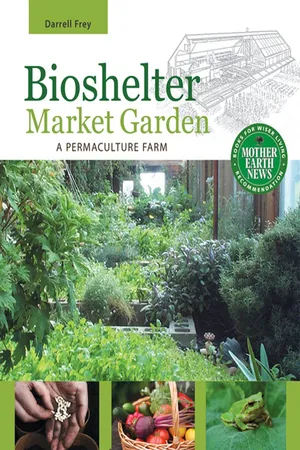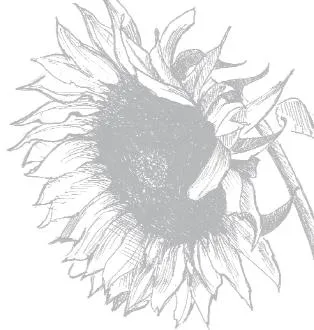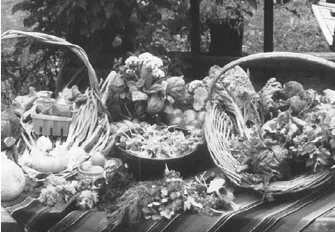
This is a test
- 480 pages
- English
- ePUB (mobile friendly)
- Available on iOS & Android
eBook - ePub
Book details
Book preview
Table of contents
Citations
About This Book
- Author has over 25 years of experience in permaculture design, both practically and as a teacher and consultant, and 20years as a market gardener.
- Audience for this book will be sustainability students, teachers, environmental educators, permaculture practitioners, market gardeners, home gardeners, community planners, landscape architects and anyone interested in food security.
- This book is unique as it provides a wealth of details for designing and managing a small-scale intensive permaculture farm, while examining the integration of architecture on agriculture. The bioshelters offer a low carbon way to extend crop production right through the winter months.
- This is a detailed case study of the ecological farm and greenhouse design and management at Three Sisters Farm and Nursery, which has been in place for almost 30 years. It is intended as a tool to help others develop small-scale intensive permaculture farms, offering profiles of not only Three Sisters, but also other bioshelters and gardens.
- Based on 30 years of experience, this book is intended as a manual for those seeking to create permaculture farms, with topics ranging from food systems and diet, marketing, design, and management.
- Author will promote his book through his website, local and regional media and at conferences
Frequently asked questions
At the moment all of our mobile-responsive ePub books are available to download via the app. Most of our PDFs are also available to download and we're working on making the final remaining ones downloadable now. Learn more here.
Both plans give you full access to the library and all of Perlego’s features. The only differences are the price and subscription period: With the annual plan you’ll save around 30% compared to 12 months on the monthly plan.
We are an online textbook subscription service, where you can get access to an entire online library for less than the price of a single book per month. With over 1 million books across 1000+ topics, we’ve got you covered! Learn more here.
Look out for the read-aloud symbol on your next book to see if you can listen to it. The read-aloud tool reads text aloud for you, highlighting the text as it is being read. You can pause it, speed it up and slow it down. Learn more here.
Yes, you can access Bioshelter Market Garden by Darrell Frey in PDF and/or ePUB format, as well as other popular books in Biological Sciences & Horticulture. We have over one million books available in our catalogue for you to explore.
Information
Subtopic
HorticultureIndex
Biological Sciences
CHAPTER 1
Toward a Permanent Culture
Toward a Permanent Culture
Life — all life — is in the service of life. Necessary nutrients are made available to life by life in greater and greater richness as the diversity of life increases. The entire landscape comes alive, filled with relationships and relationships within relationships.
—FRANK HERBERT, Dune
—FRANK HERBERT, Dune
Prologue
VAST CHALLENGES FACE OUR RELATIONSHIP to our planet. Although these challenges are now topics on the evening news, they are not new. Many people have been working for decades to alert the general public to the myriad human-caused environmental problems and social and economic inequities, that are, in a word, unsustainable.
To the student of permaculture, problems are signposts pointing to solutions. Permaculture attempts to find solutions in cultural and ecological systems rather than technology. The environmentalist adage that technological solutions breed new technological problems has proven true. The converse can be true of ecological solutions. Thoughtful application of ecological design for problem solving can set in motion regeneration of soil, watersheds and local ecosystems that in turn help heal regional and global environments.
It is easy to forget that everything is connected. The choices we make in how we grow and sell our food, the energy we use to produce our products, and the way we manage our diminishing resources all have effects for the entire planet.
All the tools and information needed to design and plan sustainable communities are available now. The question is whether we decide to use those tools or not. And the consequences won’t affect only us. As developing nations seek to emulate Western culture, Western culture needs to demonstrate stewardship based on scientific understanding and environmental consciousness.
One cannot predict what a long-term sustainable future will look like. But we believe it will be rooted in the land. It will come as an organic outgrowth of a rekindled dynamic relationship between people and their landscape. The book in your hands is intended to be a tool for those who want to participate in the continuing evolution of a sustainable society.
Book Outline
This book is roughly divided into two parts. The first part, chapters 1 through 6, introduces permaculture concepts and methods for designing a permaculture market garden farm. The second part, chapters 7 through 15, provides a detailed study of permaculture design applied to Three Sisters Farm’s activities, landscapes, and the bioshelter.
This first chapter introduces the concept of a sustainable food system and permaculture design with a first look at Three Sisters Farm. Chapter 2 examines issues relevant to safe, healthful and secure food systems. Chapter 3 looks at marketing options and strategies for the small farm. (Note that in this book the word “marketing” does not mean advertising. For us “marketing” and “selling” are almost interchangeable, but the word “marketing” evokes our role as farmers who produce crops to sell at a particular community’s local market.) Chapter 4 details the use of permaculture to design and plan a small-scale, year-round, intensive farm, with staged development. Chapter 5 looks closely at sustainable energy systems on the farm. The final introductory chapter, Chapter 6, presents ecological strategies and methods for controlling pests and disease.

Chapter 7 and 8 begin a closer study of Three Sisters Farm, looking at the details of farm design and management, crops and tools and seasonal work cycles. Chapters 9 and 10 finally come to the study of bioshelter design and management. A bioshelter is essentially a solar greenhouse managed as an indoor ecosystem. Our bioshelter is the heart of our farm, and the preceding chapters provide the necessary context for understanding its role on the farm. Chapters 11 and 12 examine details of the role of compost and chickens in the bioshelter and on the farm. Chapter 13, “Permaculture for Wetlands,” is offered as a tool for preserving wetlands and learning to use the special capabilities of wetland plants in our landscapes. Chapter 14 presents the farm as an education center, both as a source of revenue and as a service to the community. And finally, chapter 15, “Knowing Home,” and the epilogue look at the ongoing development of the farm and the application of permaculture to our own homestead. The appendix provides facts and figures related to solar design.
Five Acres and Interdependence
Three Sisters Farm began as a five-acre field of bare soil and corn stubble. The soil was good silt loam, but had been depleted of life and nutrients by decades of conventional agriculture. A scrubby tree line on the abandoned barbed wire fencerow defined the space but added little diversity. The year was 1983. We were starting with a clean slate. On this open field, we could put into practice the permaculture theory we wanted to explore. Our youthful idealism was influenced by philosopher Stephen Gaskin, of The Farm, an intentional community in rural Tennessee. To paraphrase Gaskin’s Zen-inspired directive, “If you see a problem, you probably should fix it.” Thus empowered, we began our preparations to become part of the solution — as permaculture market gardeners.
The chapters that follow provide a narrative of the changes that have occurred in this small field since 1983. Though our work is framed by human intent, our palette and canvas is provided by nature. As we’ve followed an unfolding vision of what we wanted the farm to be, we have been guided by the principle of caring for the earth so she will care for us. Our farm has been an experiment in permaculture design. And it has been an attempt to forge a right livelihood out of the universal struggle to survive and prosper.
This book functions on several levels. While it closely examines Three Sisters Farm and the bioshelter concept, it also presents a broader picture of sustainable food systems and the larger role farms can play in a sustainable society. Three Sisters is just one regional project among many. In this book, I also examine the work that others are doing developing gardens, landscapes and bioshelters, and integrating community and educational activities into the farm plan. There is a growing momentum toward the development of sustainable food systems. People of all ages, but especially young people, are drawn to a life closer to the earth and closer to the source of fresh food.
The Value of the Small-Scale Farm
The small-scale intensive farm can offer many benefits to a community and a region: food security is enhanced, organic matter and excess fertilizer are removed from the waste stream, healthy soil is built, streams are cleaner, and groundwater is recharged. The organic farm, with its diversity of crops and other plantings, enhances local biodiversity and helps create and preserve critical habitat for wildlife, especially birds and pollinating insects. Farms offer jobs and training. They can also engender many related enterprises, including craft production and value-added processing. The small-scale intensive farm can offer a pleasant space for social gatherings and community events, and there are many opportunities for educational activities and for reconnecting the community to the earth. Local culture as a whole is enhanced when local foods are available, events are seasonal, and people have direct access to nature and agriculture.
Food
Fresh, local, and organic food should be accessible to everyone. The fact that this is a political statement is unfortunate. “Be on good terms with all people,” say the great teachers. But declaring oneself organic apparently implies that something is wrong with how the “conventional farmer” farms. Similarly, to promote the superiority of fresh, local food somehow impugns the entire food industry and the global economy. Although it’s true we would prefer that no one use chemical fertilizer, herbicides or insecticides, we know that national and international trade is here to stay. And we recognize and applaud the moves toward more sustainable agriculture that many conventional farmers are making.
What we do mean to imply, or rather, to state clearly, is that much of our food can be produced locally, in a manner that helps preserve and heal the planet, build strong communities and make us healthier in the process.

Spring Peepers.
Biodiversity
We live in a world of expanding populations and diminishing natural resources. A changing climate is putting further stresses on the natural world. As wildlands continue to be developed, remaining habitat becomes ever more critical to the health of the planet. We can address these issues through thoughtful and informed land use. The ecologically designed agricultural landscape is a contribution to the preservation of natural habitat and biodiversity.
Protecting biodiversity includes protecting the quality of water in our streams and rivers, preserving critical habitat and undeveloped wildlands, managing forests sustainably, using and preserving native plants in our landscapes, protecting native pollinators and promoting habitat for the entire web of the natural world. Nature is the matrix within which we must develop our production systems.
Education
A farm is a valuable educational facility that offers many different types of instruction — organic gardening, diet and nutrition, nutrient cycling, diverse agricultural enterprises and the farm’s interconnection with the natural world. Many young people seek internships on working farms to learn the trade. Home gardeners seek out advice and opportunities to learn. At a farm, children can learn to love the earth and begin to understand its processes. It all begins with personal contact with nature. All of these things are services the farm can provide to a community while at the same time earning income to keep the farm viable. As visitors learn the value of the farm on the landscape and of fresh local food in their diet, they become customers of the farm.
Benefits of Small-Scale Intensive Agriculture
• Food security
• Employment
• Nutrient cycling
• Biodiversity
• Pollinator preservation
• Water cycling
• Education
• Social space for gatherings
• Building a local food system
• Right livelihood in a community
• Sustainable food systems
Creation of Sustainable Local Food Systems
Challenges to the revitalization and re-creation of regional food systems are many — and formidable — but they are not insurmountable. The economic viability of small farms is the foremost challenge. Competition with global food systems requires creative design, management and marketing. Start-up cost support and innovative partnership funding is often required. Other issues include access to land and resources, zoning and tax laws, insurance costs and the seasonal nature of most farm incomes. Because we are in the process of re-creating local and regional food systems, there are many missing links in support structures and market access.
Making a living from agriculture has always been difficult. One is dependent on the weather, the market and the quality of the labor force. All are variable. Because cash flow is seasonal and not always dependable, most agricultural enterprises rely on the farmer to wear a lot of hats. Besides being able to plan and manage crop production, soil fertility and other farm resources, the farmer needs to be a capable mechanic, carpenter, electrician, plumber, supervisor, planner, accountant, marketer, office manager — and gardener. An organic and permaculture farmer also needs to be an ecologist, an ecological designer and planner, a natural builder and an alternative energy specialist. Knowledge about regulations for organic certification, compost management, health and safety requirements and tax codes also is required.
Farming is rightfully said to be a lifestyle choice. You do not get rich farming, but you can profit in many ways. People are drawn to a rural lifestyle to be close to nature, to benefit from the slower pace of traffic and life in general and to engage in the care and nurturing of plants and animals. However, you need more than to eat well and have a roof over your head and shoes on your feet. Because health care and education are primary needs for most families, the majority of small-scale farmers are either part-time farmers or they have other income. Many people retire on a pension or savings account to become market gardeners as a second career. Part-time, seasonal work or a working spouse is often inevitable for the small farmer trying to compete with the global economy.
A local food system that truly supports the sustainable farm’s economic viability requires not only creativity and innovation but also the support and assistance of community leaders, local government, national policy and consumers.
In a very real sense, a return to regional food systems is a return to life of a century ago. Home food systems, supported and supplemented by neighborhood farmers markets, grocers, butchers, and the milkmen, fed the nation well. As we attune to the role of being good earth stewards in our daily lives, we will see the value of lower energy-use models of the 18th and early 19th centuries.
All these issues are examined in the chapters ahead. The picture I portray, of a diverse agricultural enterprise, demonstrates permaculture farms’ role in the regional food system and local community.
In the su...
Table of contents
- COVER PAGE
- TITLE PAGE
- COPYRIGHT PAGE
- CONTENTS
- ACKNOWLEDGMENTS
- INTRODUCTION
- CHAPTER 1: TOWARD A PERMANENT CULTURE
- CHAPTER 2: SUSTAINABLE FOOD SYSTEMS: SAFE, HEALTHFUL AND SECURE
- CHAPTER 3: DIRECT MARKETING FOR A SMALL FARM
- CHAPTER 4: THE PERMACULTURE FARM: DESIGN
- CHAPTER 5: ENERGY SYSTEMS ON THE FARM
- CHAPTER 6: BEYOND INTEGRATED PEST CONTROL: INSECTS, DISEASE, WEEDS AND OTHER PESTS
- CHAPTER 7: THE MARKET GARDEN FARM: MANAGEMENT
- CHAPTER 8: SEASONS OF THE GARDEN
- CHAPTER 9: BIOSHELTER DEFINED AND DESIGNED
- CHAPTER 10: BIOSHELTER MANAGEMENT
- CHAPTER 11: COMPOST AND BIOTHERMAL RESOURCES
- CHAPTER 12: CHICKENS IN THE GREENHOUSE
- CHAPTER 13: PERMACULTURE FOR WETLANDS
- CHAPTER 14: EDUCATION ON THE FARM
- CHAPTER 15: HOME SWEET HOME
- EPILOGUE: THE FARM ECOSYSTEM EVOLVES
- APPENDIX A (TO CHAPTER 11): APPLICABLE REGULATIONS FOR AGRICULTURAL COMPOSTING N PENNSYLVANIA
- APPENDIX B (TO CHAPTER 11): COMPOST CALCULATIONS
- APPENDIX C: GREENHOUSE HEAT DYNAMICS: FIGURING SOLAR GAIN, SOLAR STORAGE, AND HEAT LOSS
- ABOUT THE AUTHOR